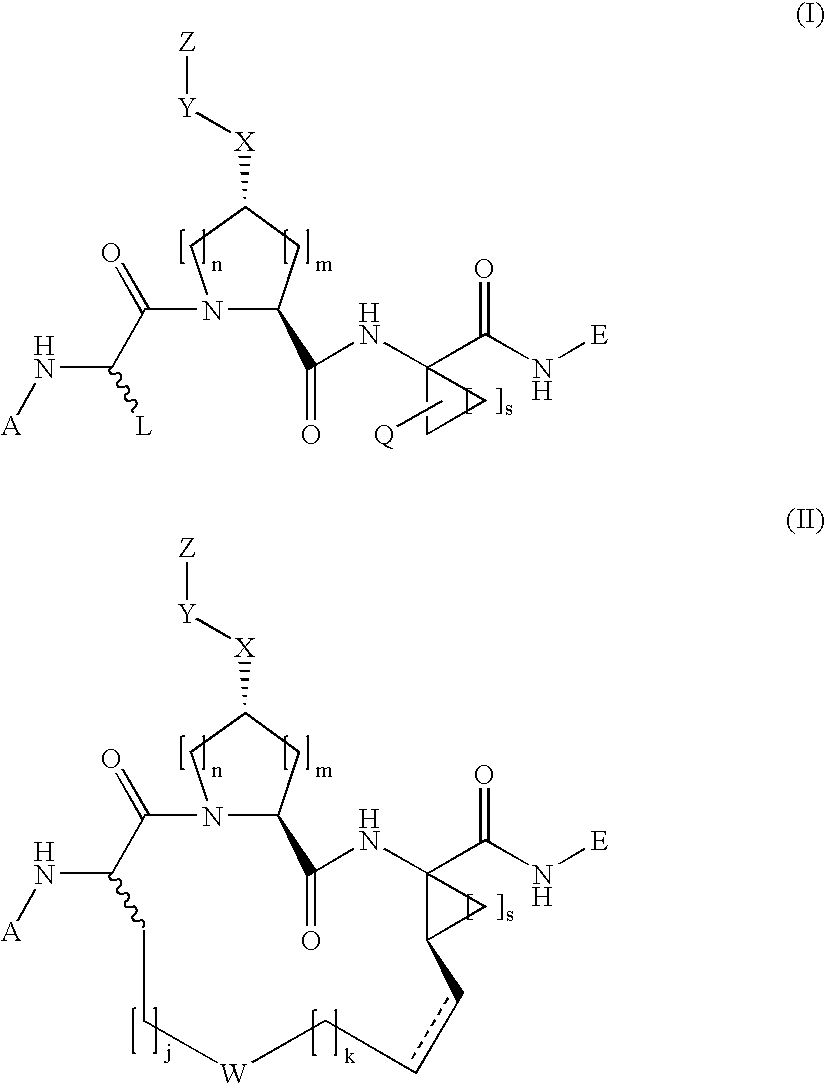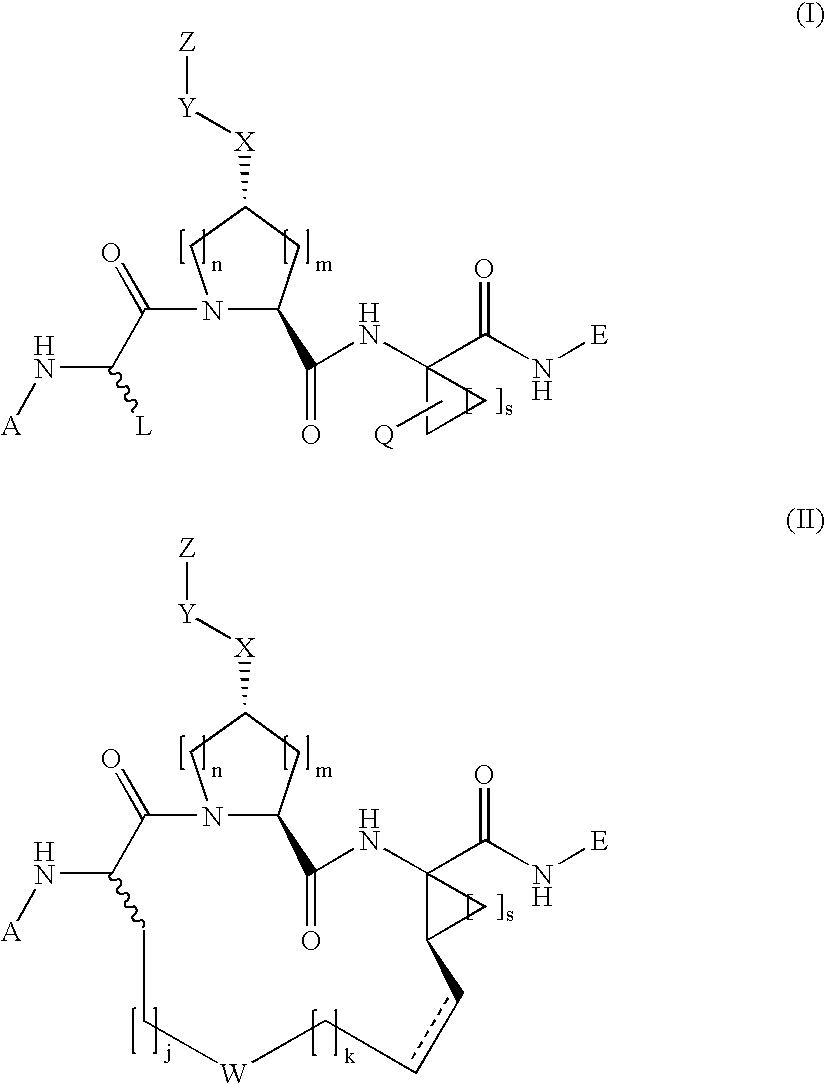N-functionalized amides as hepatitis c serine protease inhibitors
- Summary
- Abstract
- Description
- Claims
- Application Information
AI Technical Summary
Benefits of technology
Problems solved by technology
Method used
Image
Examples
example 1
Synthesis of the Tri-Peptide Intermediates
Note: This Sequence was Also Carried Out Using the Trans-Hyroxy Proline Compound, Analogous to Structure 1-a
[0242]
[0243]Step 1A. To a solution of commercially available cis-L-hydroxyproline methyl ester (1-a) (1.00 g, 4.1 mmol) in 165 ml of a 3:1:1 mixture of THF / MeOH / water at room temperature was added LiOH.H2O (0.51 g, 12.2 mmol). The resulting heterogeneous reaction was stirred at room temperature for 14 h, at which time the reaction was concentrated to ⅕ of its original volume, then acidified with 6 M HCl(aq). This aqueous solution was then diluted with 20 mL brine and extracted with DCM (4×50 mL). The organic washings were combined, washed once with brine, dried (Na2SO4), filtered, and concentrated in vacuo. The resulting crude carboxylic acid 1-b was carried on without further purification.
[0244]Step 1B. Carboxylic acid 1-b (4.08 mmol) was diluted with 50 mL of DCM, cooled to 0° C., then consecutively treated with DIEA (4.1 g, 32.6 mmo...
example 2
Compound of Formula XIII, wherein
[0254]
[0255]To a cooled mixture of macrocyclic precursor 1-i, 3-(thiophen-2-yl)-1H-quinoxalin-2-one 2a (1.1 equiv.), and triphenylphosphine (2 equiv.) in THF was added DIAD (2 equiv.) dropwise at 0° C. The resulting mixture was held at 0° C. for 15 min. before being warmed to room temperature. After 18 hours, the mixture was concentrated under vacuum and the residue was purified by chromatography eluting with 60% ethyl acetate-hexane to give 2b as a clear oil (35 mg, 99%).
[0256]MS (found): 704.4 (M+H).
[0257]H1—NMR [CDCl3, δ (ppm)]: 8.6 (d, 1H), 8.0 (d, 1H), 7.8 (d, 1H), 7.6 (m, 2H), 7.5 (d, 2H), 7.2 (t, 1H), 7.0 (brs, 1H), 6.0 (brt, 1H), 5.5 (m, 1H), 5.3 (brd, 1H), 5.2 (t, 1H), 5.0 (m. 1H), 4.6 (brt, 1H), 4.1-4.3 (m, 3H), 3.1 (m, 1H), 5.3 (m, 1H), 2.1-2.3 (m, 2H), 1.3 (brs, 9H), 1.2 (t, 3H).
[0258]A solution of compound 2b and lithium hydroxide (10 equiv.) in THF / MeOH / H2O (2:1:0.5) was stirred at room temperature for 20 hours. The excess solvents were...
example 3
Compound of Formula XIII, wherein
[0263]
[0264]Step 3A. —Amine deprotection.
[0265]The title compound of Step 2A (82 mg, 0.116 mmol) was treated with HCl (4 M in dioxane, 3 mL, 12 mmol). The reaction mixture was stirred at room temperature for 2 h until LCMS showed the complete consumption of starting material. The solvent was removed in vacuo.
[0266]Step 3B. —Chloroformate Reagent
The chloroformate reagent 3b was prepared by dissolving 0.22 mmol of cyclopentanol in THF (5 ml) and adding 0.45 mmol of phosgene in toluene (20%). The resulting reaction mixture was stirred at room temperature for 2 hours and the solvent was removed in vacuo. To the residue was added DCM and subsequently concentrated to dryness twice in vacuo yielding chloroformate reagent 3b.
[0267]Step 3C. —Carbamate formation
The resulting residue from step 3a was dissolved in CH2Cl2 (3 mL) then treated with cyclopentyl chloroformate prepared in step 3b (0.22 mmol) and iPr2NEt (0.35 mL, 2 mmol). The reaction mixture was stir...
PUM
| Property | Measurement | Unit |
|---|---|---|
| Fraction | aaaaa | aaaaa |
| Fraction | aaaaa | aaaaa |
| Composition | aaaaa | aaaaa |
Abstract
Description
Claims
Application Information
 Login to View More
Login to View More - R&D
- Intellectual Property
- Life Sciences
- Materials
- Tech Scout
- Unparalleled Data Quality
- Higher Quality Content
- 60% Fewer Hallucinations
Browse by: Latest US Patents, China's latest patents, Technical Efficacy Thesaurus, Application Domain, Technology Topic, Popular Technical Reports.
© 2025 PatSnap. All rights reserved.Legal|Privacy policy|Modern Slavery Act Transparency Statement|Sitemap|About US| Contact US: help@patsnap.com



